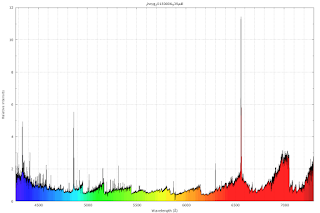Before I leave to the UK for IAS show and BAA NLO spectroscopy workshop, I do a short run tonight with the Moon almost full (well, it was a super Moon eclipse last night... I missed it due to bad weather!).
First target was VV Cep. A good opportinity to setup a special config in Prism v9 (or v10 as I already updated into a beta version of v10)... addition of a mark onto my guiding image to help during the centering process:
A cross mark indicates the position of the fiber
Setup for that mark on the guiding camera...
Details for his feature are there:
http://www.prism-astro.com/forum/viewtopic.php?f=11&t=1290&p=6732#p6732
Some information regarding VV Cep but first some tonight measurements:
-Sky Brightness around mag 18 (full Moon!)
-Seeing around 3.4"
On VV Cep, a 300sec exposure leads to a Halpha peaking around 49000 ADU.
On gamma Cas (Be starà, a 30sec exposure leads to Halpha peaking around 30000 ADU.
On BK Cam (mag 5 Be star), a 30sec exposure leads to Halpha peaking around 21000 ADU.

















































